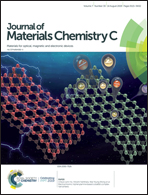Self-powered visible-blind UV photodetectors based on p-NiO nanoflakes/n-ZnO nanorod arrays with an MgO interfacial layer†
Abstract
The performance of self-powered UV photodetectors (PDs) without an external power source is far from satisfactory for practical applications. The nanostructure heterojunction-based self-powered UV PDs can enhance light absorption and provide more interface areas for photogenerated carrier separation. However, they suffer from a large dark current and low signal-to-noise ratio for carrier recombination due to thermal excitation. The p-NiO nanoflakes/n-ZnO nanorod array (NR) heterojunctions prepared by chemical bath deposition (CBD) demonstrated good rectifying characteristics and a distinct photovoltaic effect. The UV PDs based on p-NiO/n-ZnO nanostructure heterojunctions exhibited good spectral selectivity, high responsivity and a fast response speed without an external electric field under weak light radiation. The introduction of an MgO interfacial layer between NiO and ZnO NRs could modify the surface defect states of ZnO NRs and decrease the carrier recombination at the heterojunction interface, enhancing the performance of the self-powered UV PDs. The investigation of the energy band structure of the heterojunctions revealed that the self-powered photocurrent of the devices is correlated to the built-in potential of the heterojunctions. The results demonstrate that the p-NiO/n-ZnO nanostructure heterojunctions with interfacial layers are promising for the development of self-powered visible-blind UV PDs with a high performance.



 Please wait while we load your content...
Please wait while we load your content...